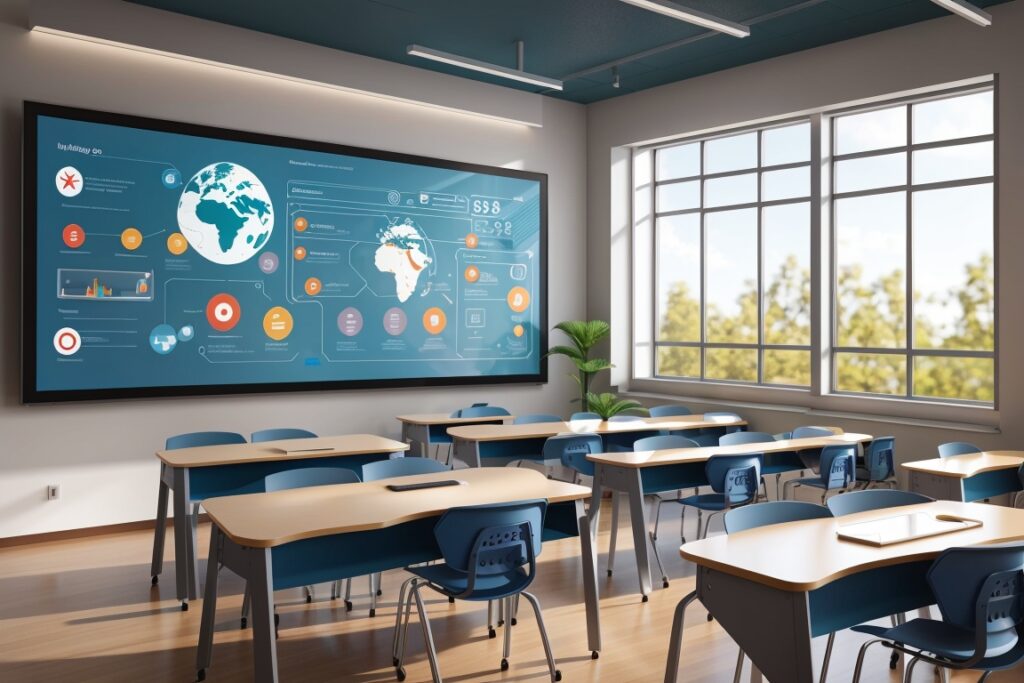
In today's fast-changing education world, bringing smart classroom tools into school is no longer optional-it has become essential. Interactive whiteboards, online lessons, AI quizzes, and cloud apps now turn ordinary rooms into lively workspaces where learners interact, create, and assess in real time. But do these gadgets and platforms actually boost student interest and improve test scores, or are they simply flashy add-ons?
The Rise of Smart Classrooms
A smart classroom links hardware and software so lessons feel hands-on instead of one-dimensional. Typical setups feature touch-enabled displays, videos, instant polls, shared file drives, and virtual team spaces that pull learners into the action rather than leave them sitting quietly. Altogether, these tools aim to build an environment that engages students, supports diverse learning styles, and moves beyond the limits of paper-and-chalk methods.
Schools in progressive regions, including many schools in Faridabad, have started adopting smart classroom solutions to provide students with modern, competitive education. Institutions like DSIS Faridabad, a top school in Faridabad, are actively embracing these innovations to foster better academic outcomes.
One of the biggest advantages of smart classrooms is the noticeable lift in student interest. Features like short videos, lively animations, hands-on simulations, and quick quizzes pull learners in and make each lesson feel more like fun than work. Unlike traditional classes where pupils sit quietly and only listen, a connected room pushes them to jump, talk, click, and question the material directly.
Add-on games, live polls, and buzzing clicker questions give eyes and hands something to do while teachers watch screens for instant signs of who gets it and who does not. Because visuals speak to sight-focused learners and sounds speak to those who, quite literally, hear the lesson, this mix touches almost every kind of brain in the room.
The same technology does more than raise spirits; it can lift grades. By collecting small bits of data after every task, AI spots what a student masters and what still feels foggy. Armed with that insight, the teacher tweaks tomorrow's plans or pulls a child into small-d-group work, and the result is deeper understanding and better long-term recall of tough ideas.
Smart kits also make blending easier by putting online quizzes, video modules, and interactive articles beside the whiteboard notes. Because learners can speed up, slow down, or replay at home, lessons stick longer and test stress shrinks.
Cloud calendars, folders, and apps push those benefits beyond bell times. A missed class? No problem. The tutorial, notes, and extra practice live online, so habits stay steady and learning stays flexible, whether the student is at school, on the bus, or lounging with a tablet after dinner.
Smart tools in the classroom do more than wow the kids; they give teachers real clout. Because instructors can see up-to-the-minute data about who is mastering the lesson and who is confused, they can tweak their approach on the fly. That quick feedback leads to tighter plans and a teaching style that meets each class where it is.
The same technology also handles grading and report writing, letting educators spend less time on paper and more time coaching students face to face.
But all that sparkle doesn't come free. Schools still have to budget for new gear, train staff so everyone feels confident, and make sure every student-can log in from home or in the library. Even then, technology should support, not replace, the caring conversations and intuitive instincts that only people bring to learning.
When chosen wisely, smart tools lift engagement and improve test scores in a big way. By making lessons interactive, personal, and open to all, they solve many of the pain points found in rows of desks and chalk dust. Institutions like DSIS Faridabad show that, with a thoughtful rollout, these innovations can turn the classroom into a thriving hub of curiosity and achievement.
Q1: What are smart classroom solutions?
Its everything from smart boards and online lesson apps to AI quizzes and cloud libraries that work together to make teaching easier and learning more lively.